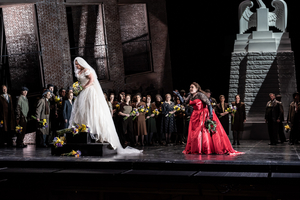Review: LOHENGRIN, Royal Opera House
A bold and brilliant staging of this Wagner masterpiece.

![]() Richard Wagner's Lohengrin may be most famous for introducing the tune of "Here Comes The Bride" to the world, but there's much more here in this stirring tale. David Alden's bold production debuted in 2018 to critical fanfare and now returns to the Royal Opera House with some excellent leads and immersive flourishes.
Richard Wagner's Lohengrin may be most famous for introducing the tune of "Here Comes The Bride" to the world, but there's much more here in this stirring tale. David Alden's bold production debuted in 2018 to critical fanfare and now returns to the Royal Opera House with some excellent leads and immersive flourishes.
When Duke Gottfried, the child-heir to Brabant, goes missing, his sister Elsa is accused of his murder by her guardian Telramund and his wife Ortrud. In her defence, she calls up a knight from her "blissful" dream. Her saviour's help comes with one condition: she never asks for his name or where he came from. Elsa agrees - but will she keep her promise?
Unlike most composers, Wagner wrote both the score and the libretto for his works according to his philosophy of Gesamtkunstwerk ("total work of art"); through a synthesis of sight, sound and script, he made music subsidiary to drama and so revolutionised opera. He also largely dismissed the use of arias to drive the plot (the first two acts feature a total of six arias) giving the opera a feeling of being sung-through. In Lohengrin, written some 20 years before The Ring Cycle saw the light of day, these concepts drive a powerful story which serves up passion and vengeance in hearty portions with side orders of war, mysticism and fascism.
The staging is magnificent from soup to nuts. Alden's heavy use of the Royal Opera Chorus either as townsfolk or soldiers adds physical volume on a par to the aural volume brought by Wagner's towering score. The American director can't do much about the slower parts of the opening act but, from the moment the curtain pulls up after the first interval, he makes the most of the meaty action and interactions to push drama levels to 11.
It's common for opera reviewers to fawn over the eye-catching dresses, but here it is Brandon Jovanovich's outfit that stands out. As the mysterious knight Lohengrin, he walks around barefoot in a brilliant white suit and open white shirt, a stark contrast against Paul Steinberg's crepuscular set design; when the spotlight is on him, Jovanovich's presence fills the massive stage. Costumer Gideon Davey doesn't skimp on the outfits for the female singers: a wonderful moment sees Elsa's beautiful wedding dress sensually lowered to her from on high while Ortrud is resplendent in a black-and-red affair which screams villainy from the top of its metaphorical lungs.
Steinberg visually pushes the action into the early 20th century and creates a series of diverse environments, switching from the huge grey buildings of Brabant (skewed at an angle suggesting that not all is right here) to an intimate boudoir for the aftermath of the wedding and then finally to the battleground where the finale plays out.
The set design is highly kinetic: Brabant's houses are smoothly and often moved around the stage to accommodate the plot, chairs and even a bed are flung around, and, in the bedroom scene, Telramund interrupts matters by bursting through the wall, sword in hand. Alden, for his part, extends the opera beyond the stage, occasionally parking musicians on the first floor and within the stalls and, before the wedding, having the chorus and the happy couple wander the aisles.
Jovanovich and Jennifer Davis (as Elsa) are magnetic as the happy pair who go from being deeply in love to fighting over Lohengrin's origins; whether locking eyes or locking horns, there is a deeply affecting quality to their acting which pulls us in. Craig Colclough is a commanding Telramund who is convincingly led astray by his (literal) witch of a wife Ortrud played superbly by Anna Smirnova. Wagner's emphasis on drama gives the four plenty to chew on and they all make an utter feast of their roles.
As a recent revival of Die Walküre showed, it is easy to get Wagner horribly wrong. Approaching his works half-cocked and as casually as the ENO did is akin to bringing a knife to a gun fight. In contrast, Alden's production meets fire with fire and creates a fantastic spectacle.
Lohengrin continues at the Royal Opera House until 14 May.
Image: Clive Barda
Videos
